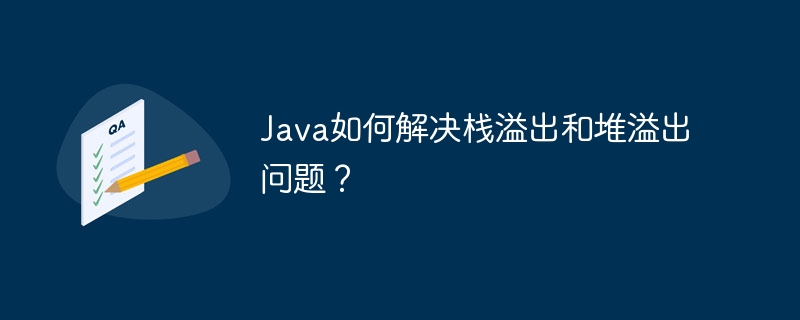Home >Java >javaTutorial >How does Java solve stack overflow and heap overflow problems?
How does Java solve stack overflow and heap overflow problems?
- 王林Original
- 2024-04-13 18:09:01793browse
Stack overflow and heap overflow in Java are caused by improper memory allocation. Stack overflow is caused by insufficient stack space due to deep recursion or a large number of local variables. This can be fixed by limiting recursion depth, using loops instead of recursions, and reducing the number of local variables. Heap overflow is caused by creating too many objects or using improper data structures. It can be fixed by avoiding creating large numbers of objects, using appropriate data structures, and releasing objects promptly. Practical examples illustrate stack overflow (using infinite recursion) and heap overflow (creating a large number of objects).

How to solve stack overflow and heap overflow in Java
Stack overflow and heap overflow are common problems that may be encountered in Java mistake. They can be triggered by mishandled recursion or memory overallocation.
Stack Overflow
Stack overflow occurs when the computer attempts to allocate more memory on the stack than it has available. The stack is used to store method calls and local variables. A stack overflow error occurs when the stack becomes full.
Fix stack overflow
- Avoid using deep recursion: Limit the recursion depth of functions to prevent infinite nesting of functions.
- Use loops instead of recursions: For large amounts of data, using loops is more efficient than recursion because it does not allocate space on the stack.
- Reduce the number of local variables: Reducing the number of local variables declared in a method can free up stack space.
Heap overflow
Heap overflow occurs when the computer attempts to allocate more memory than the available heap space. The heap is used to store objects and arrays. Heap overflow errors occur when the heap becomes full.
Fix heap overflow
- Avoid creating a large number of objects: Creating a large number of objects in a method may cause a heap overflow. Consider object pooling or other memory management techniques.
- Use appropriate data structures: Choose the appropriate data structure that best suits your application needs. For example, if you need to store a large number of elements, use an ArrayList instead of a LinkedList.
- Release objects promptly: Use the try-with-resources statement or explicitly call the object's close() method to release memory referenced by objects that are no longer needed.
Practical case: stack overflow
The following is a Java code segment that may cause stack overflow:
public class StackOverflow {
public static void main(String[] args) {
stackOverflow(0);
}
public static void stackOverflow(int n) {
stackOverflow(n + 1);
}
}This program continuously calls stackOverflow () method, which leads to infinite recursion and eventually stack overflow.
Fix: Use a loop instead of recursion, as shown below:
public class StackOverflow {
public static void main(String[] args) {
int n = 0;
while (true) {
n++;
}
}
}Practical case: Heap overflow
The following is one Java code snippets that may cause heap overflow:
public class HeapOverflow {
public static void main(String[] args) {
List<Integer> list = new ArrayList<>();
while (true) {
list.add(new Integer(1));
}
}
}This program continuously creates new Integer objects in an ArrayList, which will lead to continuous allocation of heap space and eventually lead to heap overflow.
Fix: Use object pooling or other memory management techniques to limit the number of large objects created.
The above is the detailed content of How does Java solve stack overflow and heap overflow problems?. For more information, please follow other related articles on the PHP Chinese website!
Related articles
See more- Detailed graphic explanation of CSS text overflow display ellipsis effect (text-overflow)
- What is the difference between word-wrap and text-overflow? Detailed explanation of two properties
- What does overflow mean in html5
- How to solve C++ runtime error: 'stack overflow'?
- In C language, Heap overflow and Stack overflow refer to when a program exceeds its allocated boundaries when using heap memory or stack memory.

